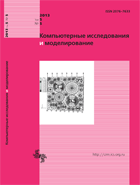All issues
- 2025 Vol. 17
- 2024 Vol. 16
- 2023 Vol. 15
- 2022 Vol. 14
- 2021 Vol. 13
- 2020 Vol. 12
- 2019 Vol. 11
- 2018 Vol. 10
- 2017 Vol. 9
- 2016 Vol. 8
- 2015 Vol. 7
- 2014 Vol. 6
- 2013 Vol. 5
- 2012 Vol. 4
- 2011 Vol. 3
- 2010 Vol. 2
- 2009 Vol. 1
Forecasting methods and models of disease spread
The number of papers addressing the forecasting of the infectious disease morbidity is rapidly growing due to accumulation of available statistical data. This article surveys the major approaches for the shortterm and the long-term morbidity forecasting. Their limitations and the practical application possibilities are pointed out. The paper presents the conventional time series analysis methods — regression and autoregressive models; machine learning-based approaches — Bayesian networks and artificial neural networks; case-based reasoning; filtration-based techniques. The most known mathematical models of infectious diseases are mentioned: classical equation-based models (deterministic and stochastic), modern simulation models (network and agent-based).
Copyright © 2013 Kondratyev M.A.
- . A Probabilistic Model for the Interaction of an Agent with a Network Environment. // Cybernetics and Systems Analysis. — 2015. — V. 51, no. 6. — P. 835. DOI: 10.1007/s10559-015-9777-y
Indexed in Scopus
Full-text version of the journal is also available on the web site of the scientific electronic library eLIBRARY.RU
The journal is included in the Russian Science Citation Index
The journal is included in the RSCI
International Interdisciplinary Conference "Mathematics. Computing. Education"







